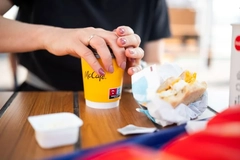Climate-smart packaging: Industry scales circularity through design and innovation

Climate-smart packaging innovation is advancing through circular design, the increased use of recycled and renewable materials, and improved recyclability across the value chain.
We speak to experts at Graphic Packaging International, PakTech, and UPM Adhesive Materials, to explore the drivers behind more environmentally sustainable packaging. We discuss how effective design, regulatory pressure, and rising consumer demand drive carbon-reduced solutions while maintaining functionality.
Design plays a pivotal role in minimizing packaging’s environmental impact and maximizing its compatibility within a circular economy, according to Michelle Fitzpatrick, vice president and chief sustainability officer at Graphic Packaging International.
“Up to 80% or more of a product’s environmental impact is determined by decisions made during its design phase. In response, we developed our Design for Environment methodology, which serves as a foundation for ensuring every new product innovation is more circular, functional, and convenient than existing alternatives.”
Graphic Packaging International’s key features for circularity include minimal weight, volume, wall thickness, and empty space ratio; high paper, renewable, and recycled content; low plastic content; exclusion of toxic and persistent chemicals; low carbon footprint in the value chain (Scope 3 GHG emissions); design for recyclability; high actual recycling rates (or, alternatively, biodegradability and compostability), and reusability by design.
“In addition, any plastic-alternative solution must also be fit for purpose and deliver the level of operational efficiency required by producers and the performance, function, and convenience that retailers and their consumers expect,” says Fitzpatrick.
Planet-friendly packaging
Packaging that is climate smart protects the product and the planet. While definitions can vary, a strong benchmark comes from the Sustainable Packaging Alliance, which outlines four essential pillars: sustainable packaging must be effective, efficient, cyclic, and clean.
 Graphic Packaging International’s paperboard sushi packaging (Image credit: Graphic Packaging International).
Graphic Packaging International’s paperboard sushi packaging (Image credit: Graphic Packaging International).
“This means designing solutions that optimize material and energy use, are safe for people and ecosystems, and engineered with the principle of circularity in mind,” Gary Panknin, sustainability officer and supply chain manager at PakTech, tells us.
“A material like recycled HDPE (rHDPE) is a great example: it’s fully recyclable, derived from post-consumer waste, and can be reintegrated into the value chain multiple times. But recyclability in theory isn’t enough. That’s why we work closely with materials recovery facilities to validate our packaging’s compatibility with real-world sorting and recycling systems.”
“At the same time, performance should never be a trade-off. Especially in secondary packaging, climate-smart design must still deliver on functionality, providing secure carrying and ensuring a seamless experience for brands and consumers alike.”
Meanwhile, UPM Adhesive Materials highlights Carbon Action — an ISCC PLUS certified bio-circular face film made with 30% renewable content on a mass-balance basis. The material is part of the company’s Smart product portfolio.
“This label promotes increased circularity and helps producers take their next step in packaging carbon footprint reduction,” Przemysław Sawa, director for Consumer Label Solutions in EMEIA at UPM Adhesive Materials, tells us.
“While the label may seem to be a small part of the packaging puzzle, it’s crucial that the entire package can be successfully recycled to enable raw materials to have a second life to truly support the circular economy. Therefore, even something as small as the self-adhesive label becomes an integral part of the whole package, with recyclability determined based on this.”
“The label material is recycling compatible with specified material streams, and available for example with wash-off adhesives that support PET recycling.”
Paper and recycled plastic innovations
Graphic Packaging International’s PaperSeal portfolio of paperboard food trays uses more than 90% less plastic than traditional trays for fresh, refrigerated, and frozen foods.  PakTech’s rHDPE handles (Image credit: PakTech).
PakTech’s rHDPE handles (Image credit: PakTech).
“UK retailer Morrisons will eliminate approximately 250 metric tons of plastic per year from their supply chain by using our pressed paperboard trays. And our award-winning PaperSeal Shape tray for Sainsbury’s eliminated over 300 metric tons of plastic annually from the retailer’s supply chain,” says Fitzpatrick.
Meanwhile, PakTech’s multipack handles are made from 100% rHDPE, sourced from post-consumer plastic waste, and fully recyclable. “By eliminating virgin plastics, we’re actively supporting circular material flows, closing the loop on plastic and reducing waste to landfills and marine ecosystems,” says Panknin.
He explains that compared to the same amount of virgin plastic, PakTech’s rHDPE handles production uses 90% less energy, requires no petroleum, and avoids GHG emissions equivalent to removing over 1,600 cars from the road each year.
“A recent milestone in our portfolio was the removal of carbon black pigment from all our handle lines. This colorant, though commonly used, can impair detectability in recycling systems, effectively limiting the final amount of recycled plastic. We have replaced it with a near infra-red detectable pigment made from renewable, grain-based biomaterials,” adds Panknin.
Consumer sustainability awareness
Climate-smartness is playing an increasingly important role in customer preferences. Sustainability is no longer a nice-to-have but an expectation for many shoppers.
“Consumers are increasingly concerned about climate change. They believe that humanity is not doing enough and recycling is one of the best ways to stop it,” says Fitzpatrick.
“Preferences continue to shift away from plastic packaging in favor of materials they perceive to be more sustainable, like paperboard.”
But Panknin says PakTech’s recycled plastic handles offer superior climate benefits. However, material distinctions can get lost “amid a flood of eco-claims.”
“It’s a reminder that education is just as important as innovation. Helping customers and consumers understand the real impact of material choices is key to accelerating meaningful change.”
 UPM Adhesive Materials’ Carbon Action label (Image credit: UPM Adhesive Materials).
UPM Adhesive Materials’ Carbon Action label (Image credit: UPM Adhesive Materials).
Sawa says that consumers today are more educated and interested in the environmental impact of the products they buy.
“This increased awareness is shaping consumer purchasing habits, and therefore it is critical that any sustainability claims are supported with science-based data that instills confidence all throughout the value chain, right through to the consumer.”
Pankin adds that attitudes toward sustainable packaging are complex and can vary depending on geography, cultural norms, and the maturity of local waste management systems.
“Consumers typically view packaging producers and brand owners, rather than themselves, retailers, or regulators, as primarily responsible for advancing packaging sustainability. As such, it falls on these stakeholders to select materials that align with sustainability standards and support corporate ESG goals and plastic reduction commitments.”
“The most notable shift we observe is among younger generations — Gen Z and Millennials — who are more willing to pay a premium for packaging that aligns with their values. However, we do notice some confusion, particularly around the differences between virgin plastic and recycled content.”
Regulations drive progress
Packaging experts expect the global regulatory landscape to continue to shape consumer packaging.
“In Europe, the Packaging and Packaging Waste Regulation, for example, is already catalyzing brands to explore more minimal packaging made with highly circular materials. In response, we expect brands will seek more plastic substitutions with highly recyclable and recycled content, like paperboard packaging,” says Fitzpatrick.
“Additionally, we expect future advancements in low-carbon, climate-smart technologies will further transform operations in the packaging industry. We will need to look to new processes and technologies as the world adapts to global warming, biodiversity loss, and increasing resource scarcity.” Graphic Packaging International’s insulated fiber beverage cups (Image credit: Graphic Packaging International).
Graphic Packaging International’s insulated fiber beverage cups (Image credit: Graphic Packaging International).
Pankin says PakTech expects to see a strong momentum toward increased use of recycled content in packaging.
“We will see continued innovation in materials, including rHDPE and in the infrastructure supporting these, such as improved sorting technologies and stronger alignment between packaging design and recovery systems.”
“This is especially important as EPR frameworks begin to take shape in more markets, which will play a key role in driving long-term progress.”
Sawa at UPM Adhesive Materials adds that this raft of new legislation is driving change, and demand from brand owners for innovative climate-smart material solutions has risen.
“It is vital for the designed for recyclability principles to be front and centre of packaging design. As a result, material choices for labels will increasingly play a critical role in the design process, to ensure regulatory compliance,” he says.











